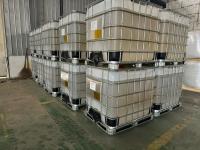Our Products
Product Center / The equivalent model of polyamine(FL2949)used for mineral processing

What is FL2949?
FL 2949 is a high‐charge, cationic organic coagulant/polyamine developed by SNF Floerger (or associated with the Floquat® brand). It is described as a polyamine used in water/wastewater treatment to reduce coagulation time and sludge volume. In the context of mineral processing and mine water treatment, FL 2949 has been shown to act as a primary coagulant: for example one study found that using 10 mg/L of FL 2949 followed by a flocculant reduced turbidity of mine water to 0 NTU within 20 minutes. Essentially, FL 2949 helps neutralize negatively charged mineral colloids, promotes particle aggregation and aids solid–liquid separation.
In product listings, FL2949 is grouped among other polyamines (e.g., FL3249, FL3150, FL3050) with ~50% solids and differing viscosities, used for water treatment and mineral processing. Thus, FL 2949 is a specialized high‐charge cationic polymer used upstream of flocculants in mineral slurry/clearance water treatment, tailings management, clarification, etc.
How is FL2949 applied in mineral processing?
In mineral processing and mining operations, the challenge often lies in dealing with fine suspended particles, slimes, clays and dispersed mineral colloids that do not readily settle. Use of a cationic coagulant such as FL 2949 helps in the process by:
-
Neutralizing the negative surface charge of fine particles/colloids → reducing repulsion.
-
Initiating micro‐floc formation (coagulation) which reduces the quantity of residual fine solids.
-
Followed by flocculation (often with a high molecular weight polymer) to build larger flocs that settle or float.
For example, the referenced mine-water study showed the benefit of combining FL 2949 with a polymer flocculant for rapid removal of fine particles. In tailings ponds or process circuit clarifiers, FL 2949 would act as the initial charge‐neutralizer/coagulant ahead of e.g. anionic/polyacrylamide flocculants, thereby improving settling, thickening and water recovery.
Equivalent Models / Alternatives to FL2949 in Mineral Processing
When someone asks for an “equivalent model” of FL2949, they typically mean: What other products (brands, grades) provide a very similar function, charge, and performance to FL2949 for mineral processing? While exact proprietary formulations may differ, the equivalent category is “high‐charge cationic polyamine (coagulant)” for use in mineral processing/clarification. Some equivalent or comparable products/grades include:
-
Other Floquat® grades by SNF such as FL 3050, FL 3249. (These are listed alongside FL 2949 in one product listing.)
-
Generic polyamine coagulants with similar solids content (~50 %), designed for mining/clarification. For example, in a product summary from ZI-CHEM, “Poly amines FL 2949 C-57” is shown in the list of equivalent flocculants for mining/reset water treatment.
-
Alternative cationic coagulants: high‐charge polyDADMAC (polydiallyldimethylammonium chloride) or heavily charged epoxy-amine copolymers. In many instances, these can fulfill a similar role to FL2949 though charge density, viscosity, branching, and performance may differ somewhat.
-
Custom‐formulated polyamine/coagulant blends from local chemical suppliers that indicate compatibility or replacement for “FL2949” in their catalogs. For instance, “Chinafloc polyamines of FL3249 FL3150 FL3050 FL2949 … can be replaced by Chinafloc–polyamines” is stated.
So, in practice, an equivalent model for FL 2949 would be a high‐charge cationic polyamine coagulant (≈50% solids, designed for mineral processing/clarification) with similar molecular weight/viscosity/charge density characteristics, from another supplier or as a parallel product grade.
When selecting an equivalent, what to check?
To ensure the replacement (or equivalent) performs comparably in a mining/mineral processing environment, you should verify/compare the following parameters:
-
Charge density (%): High cationic charge is required to neutralize negatively charged mineral slimes. FL 2949 is high‐charge; the alternative must match or exceed this.
-
Solids content / viscosity: Typically ~50% solids for FL2949; viscosity influences dosing behaviour.
-
Molecular structure / branching: The flocculation/coagulation behaviour can differ if the polymer is linear vs. branched; the referenced study shows that structure influences performance.
-
Application dosage & performance data: Equivalent products should have reliable data in mining/clarification use—settling rates, turbidity removal, clarity, floc size, etc. For example, the mine water study used 10 mg/L FL 2949 + polymer, and achieved 0 NTU within 20 min.
-
Compatibility with downstream flocculant: In the typical sequence, the coagulant (like FL 2949) is followed by a flocculant (often anionic polyacrylamide). The equivalent must be compatible with the chosen flocculants in your system.
-
Stability in process water conditions: Mining waters may have high ionic strength, pH extremes, hardness, etc. The coagulant must remain effective under your plant conditions.
-
Supplier technical support / logistics / cost: The equivalent must come with lab test data, jar tests, dosage recommendations, and be available reliably.
Summary
In summary, the equivalent model of FL 2949 for mineral processing is essentially “a high‐charge cationic polyamine or polyamine‐based coagulant (≈50% solids) intended for mineral clarification, tailings water, slurry treatment”. When choosing an alternative, you look for similar charge density, formulation, performance in mining/sludge/clarifying waters, and documented equivalence or replacement statements by the vendor.
By replacing FL 2949 with a properly matched equivalent, a mineral processing plant can maintain or improve performance in terms of rapid solid–liquid separation, water clarity recovery, reduced tailings pond retention time, and better co‐treatment with flocculants.



763_small.jpg)
455_small.jpg)
394_small.jpg)